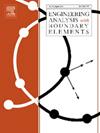基于中子输运方程离散序数的边界型算法
IF 4.2
2区 工程技术
Q1 ENGINEERING, MULTIDISCIPLINARY
Engineering Analysis with Boundary Elements
Pub Date : 2024-10-05
DOI:10.1016/j.enganabound.2024.105981
引用次数: 0
摘要
核反应堆堆芯中子通量的空间分布对确保核安全起着至关重要的作用。它可以通过求解中子输运方程来确定,其中的计算资源消耗逐渐受到越来越多的关注,尤其是在具有多重反射边界条件的问题中。通常的做法是在一个角度方向上假设初始边界值以获得全局解,然后使用反射边界条件求解其他方向,反复进行直到收敛。然而,这种方法的缺点是需要全局解,而且每次迭代都需要存储中子通量值,耗费时间和存储空间。为了解决这个问题,本文提出了一种精确高效的边界型方法--半边界法(HBM)。该方法通过积分和数学推导建立相邻节点值之间的关系,最终得到任意节点与任意方向边界值之间的关系。因此,只需要对边界值进行迭代,减少了迭代次数,从而节省了时间和存储空间。本文使用离散序数法(SN)进行角度离散化,使用 HBM 进行空间离散化,求解了以笛卡尔几何建模的二维系统的稳态中子输运方程。该方法通过几个基准问题进行了验证,包括二维 ISSA 基准问题、二维单组 k 特征值问题和 BWR 杆束测试问题。所有这些问题都显示了良好的结果,并有效地减少了计算时间。本文章由计算机程序翻译,如有差异,请以英文原文为准。
A boundary-type algorithm based on the discrete ordinates for neutron transport equation
The spatial distribution of neutron flux in the core of a nuclear reactor plays a crucial role in ensuring nuclear safety. It can be determined by solving the neutron transport equation, where computational resource consumption is gradually receiving more attention, especially in problems with multiple reflective boundary conditions. It is common practice to assume initial boundary values in one angular direction to obtain a global solution, and then use reflective boundary conditions to solve for the other directions, iterating until convergence. However, this approach has the drawback of requiring the global solution, and each iteration necessitates storing the neutron flux values, consuming time and storage space. In order to address this issue, this paper proposes a precise and efficient boundary-type method, the Half Boundary Method (HBM). This method establishes relationships between adjacent node values through integration and mathematical deduction, ultimately obtaining the relationship among any node and the boundary values in any direction. As a result, iteration is only required for boundary values, reducing the iteration amount and thus saving time and storage space. Using the discrete ordinate (SN) method for angular discretization and HBM for spatial discretization, this paper solved the steady-state neutron transport equation for two-dimensional systems modeled with Cartesian geometry. The method is validated using several benchmark problems, including the 2D ISSA benchmark, the 2D mono-group k-eigenvalue problem and BWR rod bundle test problem. All of these problems demonstrate good results and effectively reduced computational time.
求助全文
通过发布文献求助,成功后即可免费获取论文全文。
去求助
来源期刊

Engineering Analysis with Boundary Elements
工程技术-工程:综合
CiteScore
5.50
自引率
18.20%
发文量
368
审稿时长
56 days
期刊介绍:
This journal is specifically dedicated to the dissemination of the latest developments of new engineering analysis techniques using boundary elements and other mesh reduction methods.
Boundary element (BEM) and mesh reduction methods (MRM) are very active areas of research with the techniques being applied to solve increasingly complex problems. The journal stresses the importance of these applications as well as their computational aspects, reliability and robustness.
The main criteria for publication will be the originality of the work being reported, its potential usefulness and applications of the methods to new fields.
In addition to regular issues, the journal publishes a series of special issues dealing with specific areas of current research.
The journal has, for many years, provided a channel of communication between academics and industrial researchers working in mesh reduction methods
Fields Covered:
• Boundary Element Methods (BEM)
• Mesh Reduction Methods (MRM)
• Meshless Methods
• Integral Equations
• Applications of BEM/MRM in Engineering
• Numerical Methods related to BEM/MRM
• Computational Techniques
• Combination of Different Methods
• Advanced Formulations.
 求助内容:
求助内容: 应助结果提醒方式:
应助结果提醒方式:


